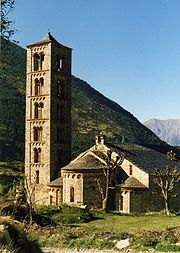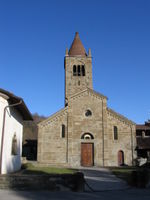
First Romanesque
Encyclopedia


Josep Puig i Cadafalch
Josep Puig i Cadafalch was a Spanish Catalan Modernista architect who designed many significant buildings in Barcelona...
to refer to the Romanesque art developed in Catalonia
Catalonia
Catalonia is an autonomous community in northeastern Spain, with the official status of a "nationality" of Spain. Catalonia comprises four provinces: Barcelona, Girona, Lleida, and Tarragona. Its capital and largest city is Barcelona. Catalonia covers an area of 32,114 km² and has an...
since the late 10th century.
The geographical proximity of this Iberian region to the rest of Europe
Europe
Europe is, by convention, one of the world's seven continents. Comprising the westernmost peninsula of Eurasia, Europe is generally 'divided' from Asia to its east by the watershed divides of the Ural and Caucasus Mountains, the Ural River, the Caspian and Black Seas, and the waterways connecting...
was brought in Catalonia demonstrations of the emerging Romanesque art
Romanesque art
Romanesque art refers to the art of Western Europe from approximately 1000 AD to the rise of the Gothic style in the 13th century, or later, depending on region. The preceding period is increasingly known as the Pre-Romanesque...
. While the art failed to take root in the rest of the Iberian Peninsula until the second third of the 11th century in the Catalan counties
Catalan counties
The Catalan counties were the administrative divisions of the eastern Carolingian Marca Hispanica created after its Frankish conquest. The various counties roughly defined what came to be known as the Principality of Catalonia....
are numerous examples above, if not fully Romanesque, do contain many of the defining characteristics of this artistic style.
To avoid the term Pre-Romanesque often used with a meaning much broader than generally fits to early Medieval and early Christian art
Early Christian art and architecture
Early Christian art and architecture is the art produced by Christians or under Christian patronage from about the year 100 to about the year 500. Prior to 100 there is no surviving art that can be called Christian with absolute certainty...
, and in Spain the Visigothic, Asturias, Mozarabic
Mozarabic art and architecture
Mozarabic Art refers to art of Mozarabs , Iberian Christians living in Al-Andalus, the Muslim conquered territories in the period that comprises from the Arab invasion of the Iberian Peninsula to the end of the 11th century, adopted some Arab customs without converting to Islam, preserving their...
and Repoblación
Repoblación art and architecture
The designation Art and Architecture of the Repoblación has been applied in recent years to the works, predominantly architectural, carried out in the Christian kingdoms of northern Spain between the end of the 9th and beginning of the 11th centuries...
, Puig i Cadafalch preferred to use the term "First Romanesque" or "first Romanesque art" to designate those Catalan anticipations of the Romanesque itself. This term is now commonly accepted.
During the first quarter of the 11th century can be seen a great architectural activity by groups composed of Lombard teachers and stonemasons who worked in all Catalan territory, erecting temples fairly uniforms. The large impeller and diffuser (and sponsor) of this art was Oliva
Abbot Oliva
Oliva was the count of Berga and Ripoll and later bishop of Vic and abbot of Sant Miquel de Cuixà. He was the son of a noble Catalan house who abdicated his secular possessions to take up the Benedictine habit in the Monastery of Santa Maria de Ripoll...
, monk and abbot of the monastery of Ripoll
Santa Maria de Ripoll
The Monastery of Santa Maria de Ripoll is a Benedictine monastery, built in the Romanesque style, located in the town of Ripoll in Catalonia, Spain...
, which in 1032 ordered extending this building with a body up front where two towers, plus a cruise which included seven apses, all decorated the outside with Lombard ornamentation of blind arches and vertical strips.
Italy
- San Pietro in Agliate (near MonzaMonzaMonza is a city and comune on the river Lambro, a tributary of the Po, in the Lombardy region of Italy some 15 km north-northeast of Milan. It is the capital of the Province of Monza and Brianza. It is best known for its Grand Prix motor racing circuit, the Autodromo Nazionale Monza.On June...
) built in 875, considered to be the probable first church with elements of Lombard Romanesque. - Priorato di Sant'Egidio
- Basilica di Santa GiuliaBasilica di Santa GiuliaThe Basilica di Santa Giulia is a medieval former church in Bonate Sotto, Lombardy, northern Italy. Built in the early 12th century, only its apse area remain today in a short plain outside the town.-History:...
- Priorato di Piona
- Baptistry of Velezzo Lomellina
- Sant'Ambrogio in Milan c. 1048
Spain
Catalonia- Sant Pere de Roda, founded 943, started construction c. 950
- Ripoll Monastery. Finished and consecrated in 977
- Church of St. Vicenç in CardonaCardonaCardona is a town ìn Catalonia, Spain, in the province of Barcelona; about 90 km northwest of the city of Barcelona, on a hill almost surrounded by the river Cardoner, a branch of the Llobregat.Near the town is an extensive deposit of rock salt...
, started in 1029 and consecrated in 1040 - Sant Cristòfol of Beget
- Sant Pere of BesalúBesalúBesalú is a town in the comarca of Garrotxa, in Catalonia, Spain.The town's importance was greater in the early Middle Ages, as capital of the county of Besalú, whose territory was roughly the same size as the current comarca of Garrotxa but sometime extended as far as Corbières, Aude, in France....
- Sant Vicenç of Besalú
- Monastery of Sant Miquel of CruïllesCruïllesCruïlles is a village in the Baix Empordà, now part of the municipality of Cruïlles, Monells i Sant Sadurní de l'Heura, which is the administrative center and location of City Hall...
- Sant Vicenç of EspinelvesEspinelvesEspinelves is a municipality in the comarca of Osona inCatalonia, Spain. It is situated in the Guilleries in the east of the comarca. Forestry is the...
- Part of Girona's CathedralGirona's CathedralThe Cathedral of Saint Mary of Girona is the cathedral church of the Roman Catholic Diocese of Girona, located in Girona, Catalonia, Spain. Its interior includes the widest Gothic nave in the world, with a width of , and the second widest overall after that of St. Peter's Basilica...
- Monastery of Sant Pere de Galligans in Girona
- Sant Nicolau in Girona
- Saint Cecil of Molló
- Church of Sant Joan in Palau-saverdera
- Monastery of Sant Quirze of ColeraCóleraCólera is a Brazilian punk rock band formed in October 1979 in São Paulo, by Redson , Val and Pierre . They are currently one of the oldest punk bands in activity in Brazil, with a career that spans almost 30 years...
in Rabós d'Empordá - Monastery of Sant Aniol d'Aguja
- Monastery of Santa Maria of VilabertranVilabertranVilabertran is a municipality in the comarca of Alt Empordà, Girona, Catalonia, Spain....
- Churches of Saint Mary and Saint Clement of TaüllSant Climent de TaüllSant Climent de Taüll is a Roman Catholic church in the town of Taüll, in the province of Lleida, Catalonia. The church was dedicated in the year 1123.The church is one of the best examples of Romanesque architecture...
, Sant Feliu, Sant Joan de Boí, Santa Maria de l'Assumpció, Santa Maria de Cardet, la Nativitat de Durro, Ermita de Sant Quiric and Santa Eulàlia, in Vall de BoíVall de BoíThe Vall de Boí is a narrow, steep-sided valley and a small municipality in the province of Lleida, in the autonomous community of Catalonia, northern Spain. It lies in the northeastern corner of the comarca of Alta Ribagorça, on the edges of the Pyrenees...
, - Churches of Santa Maria, Sant Pere and Sant Miquel in TerrassaTerrassaTerrassa is a city in the east central region of Catalonia, Spain, in the comarca of Vallès Occidental, of which it is the co-capital along with Sabadell, the historic capital....
Huesca
- Church of Saint Caprasio (Saint CaprasiusCaprasius of AgenSaint Caprasius of Agen is venerated as a Christian martyr and saint of the fourth century. Relics associated with him were discovered at Agen in the fifth century...
) in Santa Cruz de la SerósSanta Cruz de la SerósSanta Cruz de la Serós is a village in the province of Huesca, Aragon, Spain. Located 88 kilometers from the city of Huesca, it is located at a hill side on the way to the Monastery of San Juan de la Peña.-Monuments:...
(HuescaHuescaHuesca is a city in north-eastern Spain, within the autonomous community of Aragon. It is also the capital of the Spanish province of the same name and the comarca of Hoya de Huesca....
) - Monastery of San Pedro de Siresa (Huesca)
- Church of San Adrián de Sasave (Huesca)
- Church of Baros (Huesca)
- Church of Asieso (Huesca)
- Church of Binacua (Huesca)
- Churches of the Serrablo (Huesca), discussed if Romanesque or MozarabMozarabThe Mozarabs were Iberian Christians who lived under Arab Islamic rule in Al-Andalus. Their descendants remained unconverted to Islam, but did however adopt elements of Arabic language and culture...
: Ordovés, Rasal, Lasieso, Arto, Isún, Satué, Lárrade, San Juan de Busa, Oliván, Orós Bajo, Susín, Basarán (now in Formigal), Otal, S. Juan de Espierre and San Bartolomé de Gavín
Valladolid
- Nuestra Señora de la Anunciada Hermitage, in UrueñaUrueñaUrueña is a municipality located in the province of Valladolid, Castile and León, Spain. According to the 2004 census , the municipality has a population of 213 inhabitants....
France
- Saint-Etienne church in Vignory 1050-1057
- St Philibert at TournusSt Philibert at TournusSt Philibert's Church in Tournus, France, is the church of the former Benedictine abbey established here in c. 950.The building is a structure of the early First Romanesque style of Burgundy, which is beginning to use further Romanesque and early Gothic styles during the beginning of the 11th...
- Saint-Martin-du-Canigou, begun 1001
Sources
- Armi, Edson. Orders and Continuous Orders in Romanesque Architecture., Department of Art, University of Chicago. Oct 1975. pp. 173-188.
- Kostof, Spiro. A History of Architecture., Oxford: Oxford University Press, 1995.
- Chueca Goitia, Fernando Historia de la Arquitectura Española, Edad Antigua y Media Editorial DOSSAT, 1965. Chapter: El primer arte románico. pp. 148-156. ISBN 84-923918-4-7
- Chueca Goitia, Fernando Historia de la Arquitectura occidental: Edad Media cristiana en España Ed. DOSSAT, 2000. ISBN 84-95312-35-2
- Yarza, Joaquín Arte y arquitectura en España, 500-1250 Manuales arte Cátedra, 1997. ISBN 84-376-0200-9

